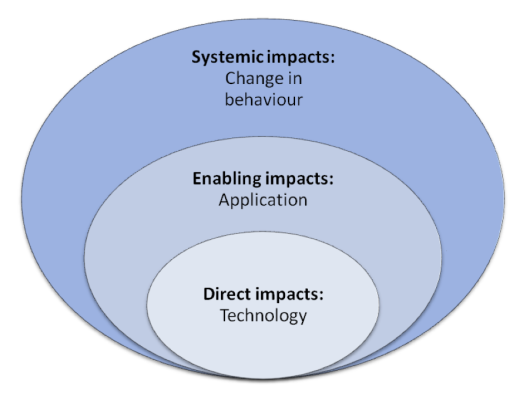From the perspective of an organization or from an ICT department, it makes sense to think about Green ICT as the direct impact of ICT on the environment. This has also been fed by a myriad of publications on how to apply best practices such as total cost of ownership and data center design and management; basically linking Green ICT to cost efficiency, making it good for your wallet as well as the environment. This view was so widespread that Green ICT was declared dead because every sensible organization had already incorporated its principles in their daily practices. This was a very narrow perspective of course, because only the cost efficient practices were considered and more often than not, this was reasoned from the ICT department instead of the entire organization or beyond. To me, Green ICT is about considering all impacts of ICT on the environment, direct or indirect, positive or negative. We have to minimize the negative impacts and maximize the positive impacts. Yes, ICT can have a positive influence and reduce our environmental footprint: it can be used as an enabler for new environmental-friendly technologies, it can be used to make other processes more efficient and thus reduce their impacts, it can be used to dematerialize atoms to bits avoiding the use of (rare) materials. It all depends on how we use ICT, in the end it remains a means to an end. So, what is beyond the direct impacts of ICT? How can ICT be part of the solution? There are indirect and systemic impacts to consider. Both can become part of the problem as well as the solution. We can use ICT to dematerialize or substitute other processes or activities: e-mail instead of paper mail, video conference instead of face-to-face meetings. Both of these substitutions increase the use and thus the impact of ICT but they will likely result in a net decrease overall. I say likely, because the use of ICT will change the way we live and work. We could suddenly send thousands more e-mails than we would paper mails (because it is so easy to do) which may negate the one-on-one efficiency gain. This change of behaviour is an example of the systemic impact of ICT (figure 1).

All these impacts might make it complicated to assess what is the right thing to do. Luckily there are a number of indicators that show that ICT in general has a dematerializing positive effect (more on this in a next post). We have to use technology to reduce our environmental footprint and ICT will play a major role in this transition to a low-carbon society. SURF has worked since 2010 with the Higher Education community in the Netherlands to learn about Green ICT. This introduction is a first blog post in what I hope to be many showing what ICT can do for the environment with cases from our community. Albert Hankel SURF & Sustainability (in Dutch)

1 Praat mee